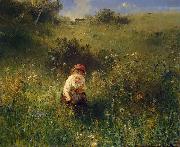Wholesale Oil Painting No Minimum |
|||||||||||
|
|
|||||||||||

|
|||||||||||
|
|
|
||||||||
Ludwig KnausGerman Painter, 1829-1910 was a German genre painter of the younger Desseldorf school. He was born at Wiesbaden and studied from 1845 to 1852 under Sohn and Schadow in Desseldorf. His early works, like "The Gamblers," in the Desseldorf Gallery, are in the manner of that school, being dark and heavy in color. This deficiency was remedied by study at Paris, whither he went in 1852 and enrolled as a pupil of Couture. In 1853 his "Morning after the Kermess" received the second gold Medal of the Salon and made him a celebrated painter. Except for a year's study in Italy he remained in Paris until 1860.New International Encyclopedia His chief works of this period include "The Golden Wedding," "The Baptism," and "The Promenade," purchased for the Luxembourg. From 1861 to 1866 he practiced at Berlin, producing such works as "Boys Playing Cards," "Looking for a Bride" (Wiesbaden Museum), and "His Highness on His Travels." The next eight years of his life saw the production of much of his best work, including "The Children's Festival" (Nation Gallery, Berlin), "In Great Distress," and "The Village Prince." From 1874 to 1883 he was professor at the Academy of Berlin, continuing to reside in that city until his death. Among the most importand works of his last period were: "The Holy Family" and "The Road to Ruin," both painted in 1876 and now in the Metropolitan Museum of Art, New York; "Behind the Curtain" (1880), Dresden Gallery; "The Rag Baby" (1880) and "A Village Festival" (1881), both in the Vanderbilt collection, Metropolitan Museum, New York; and "A Duel." During his last period Knaus also painted a series of "Idyls," with nudes in a rather classical style, of which an important example is in the Wiesbaden Museum. |
||||||||
|
|
||||||||
Girl in a Field
Girl in a Field Painting ID:: 66656 |
Oil on canvas
1857 Oil on canvas 1857 |
|||||||
|
|
||||||||
|
Ludwig Knaus German Painter, 1829-1910 was a German genre painter of the younger Desseldorf school. He was born at Wiesbaden and studied from 1845 to 1852 under Sohn and Schadow in Desseldorf. His early works, like "The Gamblers," in the Desseldorf Gallery, are in the manner of that school, being dark and heavy in color. This deficiency was remedied by study at Paris, whither he went in 1852 and enrolled as a pupil of Couture. In 1853 his "Morning after the Kermess" received the second gold Medal of the Salon and made him a celebrated painter. Except for a year's study in Italy he remained in Paris until 1860.New International Encyclopedia His chief works of this period include "The Golden Wedding," "The Baptism," and "The Promenade," purchased for the Luxembourg. From 1861 to 1866 he practiced at Berlin, producing such works as "Boys Playing Cards," "Looking for a Bride" (Wiesbaden Museum), and "His Highness on His Travels." The next eight years of his life saw the production of much of his best work, including "The Children's Festival" (Nation Gallery, Berlin), "In Great Distress," and "The Village Prince." From 1874 to 1883 he was professor at the Academy of Berlin, continuing to reside in that city until his death. Among the most importand works of his last period were: "The Holy Family" and "The Road to Ruin," both painted in 1876 and now in the Metropolitan Museum of Art, New York; "Behind the Curtain" (1880), Dresden Gallery; "The Rag Baby" (1880) and "A Village Festival" (1881), both in the Vanderbilt collection, Metropolitan Museum, New York; and "A Duel." During his last period Knaus also painted a series of "Idyls," with nudes in a rather classical style, of which an important example is in the Wiesbaden Museum. Girl in a Field Medium Oil on canvas Dimensions Unknown Current location Unknown |
||||||||
|
|
||||||||
|
Prev Next
|
||||||||
|
|
||||||||
|
Related Paintings to Ludwig Knaus :. |
||||||||
|
|
||||||||
|
CONTACT US |

